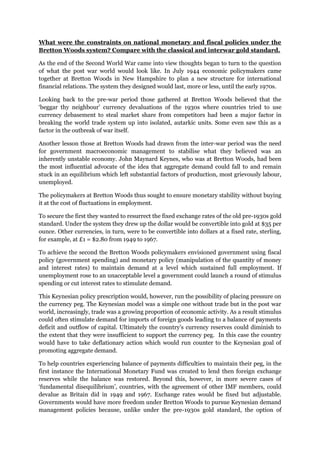
What were the constraints on national monetary and fiscal policies under the Bretton Woods system Compare with the cl
- 1. What were the constraints on national monetary and fiscal policies under the Bretton Woods system? Compare with the classical and interwar gold standard. As the end of the Second World War came into view thoughts began to turn to the question of what the post war world would look like. In July 1944 economic policymakers came together at Bretton Woods in New Hampshire to plan a new structure for international financial relations. The system they designed would last, more or less, until the early 1970s. Looking back to the pre-war period those gathered at Bretton Woods believed that the ‘beggar thy neighbour’ currency devaluations of the 1930s where countries tried to use currency debasement to steal market share from competitors had been a major factor in breaking the world trade system up into isolated, autarkic units. Some even saw this as a factor in the outbreak of war itself. Another lesson those at Bretton Woods had drawn from the inter-war period was the need for government macroeconomic management to stabilise what they believed was an inherently unstable economy. John Maynard Keynes, who was at Bretton Woods, had been the most influential advocate of the idea that aggregate demand could fall to and remain stuck in an equilibrium which left substantial factors of production, most grievously labour, unemployed. The policymakers at Bretton Woods thus sought to ensure monetary stability without buying it at the cost of fluctuations in employment. To secure the first they wanted to resurrect the fixed exchange rates of the old pre-1930s gold standard. Under the system they drew up the dollar would be convertible into gold at $35 per ounce. Other currencies, in turn, were to be convertible into dollars at a fixed rate, sterling, for example, at £1 = $2.80 from 1949 to 1967. To achieve the second the Bretton Woods policymakers envisioned government using fiscal policy (government spending) and monetary policy (manipulation of the quantity of money and interest rates) to maintain demand at a level which sustained full employment. If unemployment rose to an unacceptable level a government could launch a round of stimulus spending or cut interest rates to stimulate demand. This Keynesian policy prescription would, however, run the possibility of placing pressure on the currency peg. The Keynesian model was a simple one without trade but in the post war world, increasingly, trade was a growing proportion of economic activity. As a result stimulus could often stimulate demand for imports of foreign goods leading to a balance of payments deficit and outflow of capital. Ultimately the country’s currency reserves could diminish to the extent that they were insufficient to support the currency peg. In this case the country would have to take deflationary action which would run counter to the Keynesian goal of promoting aggregate demand. To help countries experiencing balance of payments difficulties to maintain their peg, in the first instance the International Monetary Fund was created to lend then foreign exchange reserves while the balance was restored. Beyond this, however, in more severe cases of ‘fundamental disequilibrium’, countries, with the agreement of other IMF members, could devalue as Britain did in 1949 and 1967. Exchange rates would be fixed but adjustable. Governments would have more freedom under Bretton Woods to pursue Keynesian demand management policies because, unlike under the pre-1930s gold standard, the option of
- 2. devaluation was explicitly offered. “Exchange rates would thus be allowed to be brought into conformity with seriously misaligned price levels – not the reverse as under the gold standard” (Artis p 40) This arrangement can be examined through the prism of the monetary policy trilemma which states that a country can have any two but not all three of 1) fixed exchange rates, 2) an independent monetary policy, and 3) free movement of capital. To avoid the monetary nationalism of the 1930s and facilitate trade the Bretton Woods system chose fixed exchange rates and to allow for Keynesian demand management it chose an independent monetary policy. This meant that countries had to give up the free movement of capital. This was seen as no great sacrifice in any event as capital markets had dried up in the 1930s and were not expected to return with their old vitality. In their place Bretton Woods erected a further structure, the International Bank of Reconstruction and Development, later the World Bank. This differs from the classical gold standard. This differs from the classical gold standard. Under that system countries adopted a fixed exchange rate, free movement of capital, and eschewed an independent monetary policy. Instead, monetary policy was geared towards maintenance of the exchange rate whereas under Bretton Woods it was geared towards maintaining domestic employment. Different constraints for reserve countries, sterling and dollar then just the dollar
